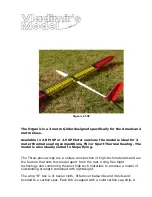
Note: - Further items will need to be purchased in order to complete
this model.
Receiver, battery, 5 – servos and Hoopes wiring harness
Glider /electric Version: -
1.) Wings: -
Feed the Aileron servo wires into the ready cut slots in the wings and fit a
reliable plug and socket system to the wires to enable the panels to plug
together and the wing servo's to plug into to the fuselage mounted receiver.
We recommend using the Hoops Wiring Harness. These will fit directly into the
pre- cut slots in the root ribs.
Prior to mounting the aileron servo's into the wing servo wells, clean any
release agent from the Carbon Sheeting inside the servo well using acetone,
and abrade the surface to ensure a good bond to the servo or mounting rails.
The servo's can be secured using hardwood blocks bonded into the wells, the
servo's being retained with wire straps screwed into the blocks. Alternatively
the servos can be simply bonded in place using 5 minute epoxy, score or
abrade the surface of the servo to ensure a good bond. The latter is my own
preferred mounting method.
2.) Bond the aileron horns of choice to the ailerons, aligning the horn up with
the servo output arm. The flap servo is mounted in a similar way to the aileron
servos. Ensure the flap movement will give approximately 70 degrees of down
movement
3.) Vee
Tail:
Fit the Vee tail plane to the fuselage, hold the elevator horns in place and
mark out the correct position of the horns so as the horn correctly align with
the pushrods in the fuselage.
Check that the horn fits in the fuselage neatly and the tail plane will move up
and down to its full extent of travel without hindrance. Securing the elevator
horns to the elevators using epoxy or Cyo. (Ensure full elevator movement is
possible)
4.) Fuselage:
The Fuselage is delivered with a separate nose cone and inner fuselage
nose section.
Fit the completed wings and tail plane to the fuselage and tape the rudder and
elevator servos, the receiver and the receiver battery to the outside of the
























